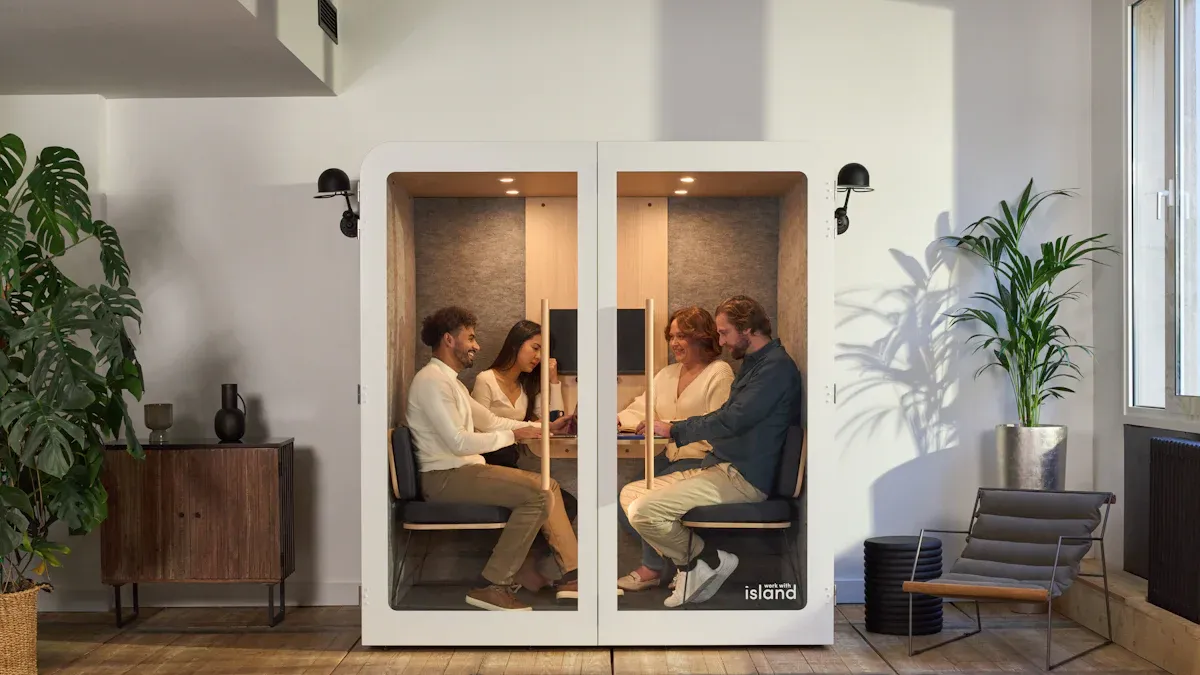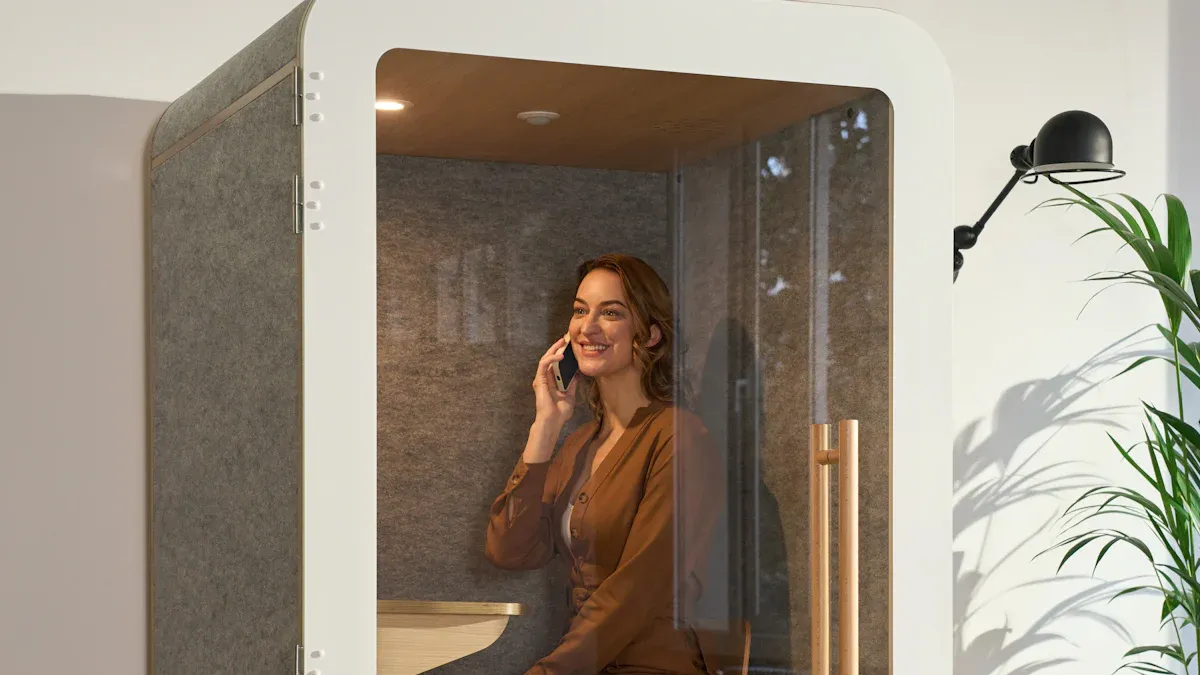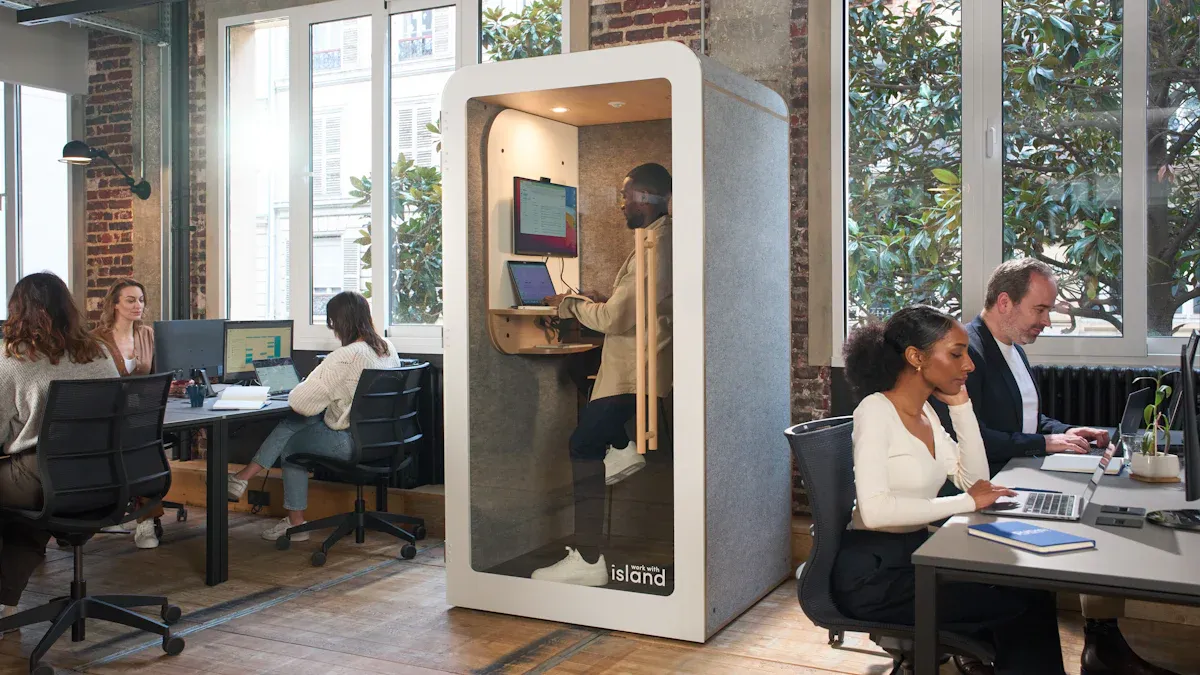
Noise can disrupt even the most focused minds. It takes about 20 minutes for someone to regain concentration after a minor sound. In a busy office, this adds up fast. A soundproof meeting room, along with our innovative office booths and pods, eliminates distractions, allowing clearer communication and stress-free collaboration. Our soundproof home office pod is perfect for remote workers seeking peace and quiet. With our Soundproof Pods, you can create an environment that enhances productivity and teamwork, making it a game-changer for any workspace.
Assessing Acoustic Challenges in Your Meeting Room
Identifying noise sources and their impact
Noise can come from many places, both inside and outside a meeting room. Common culprits include conversations in nearby spaces, office equipment like printers, and even traffic noise from outside. These distractions can make it hard for participants to focus or hear one another.
Meeting rooms often face challenges like:
- Excessive noise that disrupts discussions.
- Sound leakage, which reduces privacy.
- Poor acoustics that make it difficult for everyone to participate.
When noise levels rise, productivity drops. Studies show that workplace distractions can reduce efficiency by up to 40%. This highlights the importance of addressing these issues to create a soundproof meeting room that fosters better communication and focus.
Evaluating current soundproofing and acoustics
Before making changes, it’s important to assess the room’s current acoustic performance. Are there echoes when someone speaks? Can conversations from outside the room be heard clearly? These are signs of poor soundproofing.
A quick evaluation can reveal whether the room needs soundproofing, sound absorption, or both. For example, if echoes dominate, adding sound-absorbing materials like acoustic panels can help. If sound leaks through doors or windows, sealing gaps or upgrading materials might be necessary.
Tools for measuring noise levels
Measuring noise levels accurately helps identify problem areas. Tools like sound level meters provide precise readings. Here’s a quick comparison:
| Tool Type | Accuracy | Description |
|---|---|---|
| Type 2 (Class 2) | +/- 2 dB | General-purpose instruments suitable for most noise measurements. |
| Type 1 (Class 1) | More accurate | Used by engineers for detailed noise control surveys, ideal for advanced needs. |
Using these tools ensures that soundproofing efforts target the right issues, making the meeting room more effective for collaboration.
Soundproofing vs. Sound Absorption in a Meeting Room
Key differences between soundproofing and sound absorption
Soundproofing and sound absorption serve different purposes, though they both improve acoustics. Soundproofing blocks noise from entering or leaving a room. It focuses on creating barriers to stop sound waves. Materials like mass-loaded vinyl or double-glazed windows are common for this purpose.
Sound absorption, on the other hand, reduces echoes and improves sound clarity within a space. It works by absorbing sound waves instead of reflecting them. Acoustic panels, foam, and carpets are popular choices for this.
Think of it this way: soundproofing keeps noise out, while sound absorption makes the noise inside more manageable.
When to prioritize soundproofing over sound absorption
Soundproofing is essential when privacy or external noise is a concern. For example, a meeting room near a busy street or a noisy office area benefits from soundproofing. It ensures conversations stay private and external distractions don’t interfere.
Sound absorption becomes a priority when the focus is on improving the room’s internal acoustics. If echoes or poor sound clarity make discussions difficult, absorption materials can help.
Combining both techniques for optimal results
For the best results, combining soundproofing and sound absorption is key. A soundproof meeting room that also minimizes echoes creates an ideal environment for productivity.
- Acoustic panels and foam can absorb sound waves, reducing echoes.
- Mass-loaded vinyl and sealed windows block external noise.
- Analyzing the room’s acoustic properties ensures the right materials are used.
Advanced methods, like finite element analysis, help optimize material structures for better performance. This tailored approach ensures the meeting room meets specific acoustic needs, enhancing both privacy and clarity.
Materials and Tools for a Soundproof Meeting Room

Acoustic panels and foam for walls
Acoustic panels and foam are essential for improving the acoustics inside a meeting room. These materials absorb sound waves, reducing echoes and enhancing clarity. Panels come in various designs, allowing them to blend seamlessly with the room’s decor. Foam, often used in recording studios, works well for smaller spaces.
Installing these materials on walls helps create a quieter environment. They prevent sound from bouncing around, making conversations easier to follow. For best results, place panels strategically on surfaces where sound reflection is highest.
Tip: Choose panels with high Noise Reduction Coefficient (NRC) ratings for maximum effectiveness.
Soundproofing curtains, carpets, and flooring
Soft furnishings like curtains and carpets play a big role in soundproofing. Heavy, dense curtains block external noise while adding a touch of elegance to the room. Carpets and rugs absorb sound, reducing vibrations that travel through the floor.
Flooring materials also matter. Cork and rubber flooring are excellent choices for minimizing noise transmission. These materials dampen impact sounds, such as footsteps or dropped objects, which can disrupt meetings.
Note: Combining curtains, carpets, and soundproof flooring creates a layered approach to soundproofing, tackling multiple noise sources at once.
Sealing gaps in doors and windows
Doors and windows are common culprits for sound leakage. Even small gaps can let noise in or out, compromising the room’s privacy. Sealing these gaps is a simple yet effective solution.
Weatherstripping tape works well for doors, creating a tight seal that blocks sound. For windows, consider acoustic seals or double glazing. Double-glazed windows have two layers of glass with an insulating gap in between, which reduces noise transmission significantly.
Tip: Use door sweeps to seal the gap at the bottom of the door. This prevents sound from escaping while keeping the room insulated.
Advanced materials like mass-loaded vinyl and ceiling tiles
For serious soundproofing, advanced materials like mass-loaded vinyl (MLV) and specialized ceiling tiles are game-changers. MLV is a dense, flexible material designed to block sound transmission. It’s often used in construction and industrial settings but works equally well in meeting rooms.
Ceiling tiles with acoustic properties reduce noise from above, especially in multi-story buildings. They absorb sound and prevent it from traveling between floors.
Here’s a closer look at MLV’s properties:
| Property/Use | Description |
|---|---|
| Composition | MLV is made from a mixture of vinyl and mineral filler, providing strength and flexibility. |
| Sound Blocking | It effectively blocks sound transmission due to its density and weight. |
| Applications | Commonly used in building construction, HVAC systems, automotive, industrial settings, and home theaters. |
| Main Function | Primarily designed to stop sound from passing through rather than absorbing it. |
Integrating these materials into a soundproof meeting room ensures maximum noise control. They work well alongside other solutions like acoustic panels and sealed windows, creating a comprehensive soundproofing system.
Step-by-Step Guide to Soundproofing Your Meeting Room

Soundproofing walls with panels and insulation
Walls are one of the most significant contributors to noise leakage in a meeting room. Adding acoustic panels and insulation can drastically improve soundproofing. Acoustic panels absorb sound waves, reducing echoes and improving clarity inside the room. Insulation, on the other hand, blocks noise from traveling through walls.
Here’s how to get started:
- Choose the right panels: Look for panels with a high Noise Reduction Coefficient (NRC) rating. These panels absorb more sound, making them highly effective.
- Install insulation: Use materials like fiberglass or mineral wool inside the walls. These materials trap sound waves, preventing them from passing through.
- Combine both solutions: Pairing acoustic panels with insulation creates a dual-layer defense against noise.
Case Studies:
- TechCo Innovations installed acoustic panels in their open-plan offices. This reduced noise levels, improved employee satisfaction, and even lowered energy bills, with a payback period of two years.
- EcoRetail Superstores retrofitted their stores with sustainable acoustic panels. They achieved a 20% reduction in energy costs and created a quieter shopping environment, with a payback period of three years.
Treating ceilings with acoustic tiles and drywall
Ceilings often get overlooked during soundproofing, but they play a crucial role in controlling noise. Acoustic ceiling tiles and drywall can significantly reduce sound reflection and reverberation.
Acoustic tiles are particularly effective in modern spaces with non-porous surfaces and flexible walls. They absorb sound, filter out external noise, and create a more comfortable environment. Drywall, when combined with insulation, adds an extra layer of soundproofing.
Key benefits of acoustic ceiling treatments include:
- Managing sound reflection and resonance for better acoustics.
- Reducing reverberation in high-ceiling areas with ceiling clouds or baffles.
- Enhancing privacy with tiles that have a high Ceiling Attenuation Class (CAC).
For example, a tile with an NRC of 0.95 absorbs 95% of sound, making it highly effective. Tiles with a CAC of 35 or higher are ideal for blocking noise between rooms.
Studies show that excessive noise can hinder productivity and increase stress. Treating ceilings with acoustic tiles and drywall creates a quieter, more focused environment, perfect for a soundproof meeting room.
Upgrading doors with seals and soundproofing kits
Doors are often the weakest link in a soundproofing setup. Even small gaps around a door can let noise in or out, compromising the room’s privacy. Upgrading doors with seals and soundproofing kits is a simple yet effective solution.
Here’s what to do:
- Install weatherstripping: Apply weatherstripping tape around the edges of the door to create a tight seal.
- Add a door sweep: Attach a door sweep to the bottom of the door. This blocks sound from escaping through the gap underneath.
- Use soundproofing kits: These kits often include mass-loaded vinyl or acoustic panels designed specifically for doors.
By addressing these gaps, you can significantly reduce noise leakage. This ensures that conversations inside the meeting room remain private and free from external distractions.
Enhancing windows with double glazing and seals
Windows are another common source of noise leakage. Standard single-pane windows do little to block sound, but double glazing and proper seals can make a huge difference.
Double-glazed windows consist of two layers of glass with an insulating gap in between. This design not only improves energy efficiency but also reduces noise transmission. Adding acoustic seals further enhances their performance.
Did You Know?
Standard single-pane windows have an STC (Sound Transmission Class) rating of 26-28. Dual-pane windows typically range from 26-32. However, combining laminated glass, a 2-4 inch air gap, and improved seals can achieve STC ratings of 48-57, reducing external noise by up to 95%.
To upgrade your windows:
- Replace single-pane windows with double-glazed ones.
- Add acoustic seals around the edges to block any remaining gaps.
- Consider laminated glass for maximum noise reduction.
These upgrades not only enhance the soundproofing of your meeting room but also improve its overall energy efficiency.
Additional Tips for Enhancing Acoustics
Arranging furniture to reduce sound reflection
Furniture placement plays a big role in controlling sound reflections. Rearranging furniture can soften harsh acoustics and reduce flutter echoes. High-backed seating arranged in a circular formation helps contain conversations and minimizes noise spillover. Carpeted or fabric-covered furniture absorbs footsteps and casual chatter, enhancing overall sound quality.
Strategic furniture arrangement doesn’t just improve acoustics—it also creates a balanced spatial flow. This layout promotes productivity and employee well-being, making the meeting room more comfortable and functional.
Tip: Use soft materials like upholstered chairs and rugs to further dampen sound reflections.
Using white noise machines for residual noise masking
Even after soundproofing, some residual noise may linger. White noise machines offer a simple solution to mask these distractions. These devices produce a consistent sound that blends into the background, making other noises less noticeable.
White noise machines are especially useful in open-plan offices or meeting rooms near busy areas. They create a calming environment that enhances focus and reduces stress.
Did You Know? White noise can improve concentration by reducing the brain’s response to sudden sounds.
Regular maintenance of soundproofing materials
Soundproofing materials need regular upkeep to stay effective. Inspecting them periodically helps identify gaps or cracks that may have developed over time. Cleaning acoustic panels and fabrics ensures they maintain their performance and continue absorbing sound effectively.
A well-maintained soundproof meeting room stays functional and efficient for years. Regular checks prevent small issues from becoming bigger problems, saving time and money in the long run.
Note: Schedule maintenance every few months to keep the room’s acoustics in top shape.
Sustainable Soundproofing Solutions by Ningbo Cheerme Intelligent Furniture Co., Ltd.
Modular design and assembly for cost-effective soundproofing
Ningbo Cheerme Intelligent Furniture Co., Ltd. has revolutionized soundproofing with its modular design approach. This method allows users to assemble and disassemble meeting rooms quickly, saving both time and money. Each module is designed for easy integration, making it possible to expand or modify spaces without major disruptions.
The modular system also reduces waste during installation. Pre-fabricated components ensure precise fits, eliminating the need for excessive materials. This approach not only lowers costs but also minimizes the environmental impact.
Tip: Modular designs are perfect for businesses that anticipate growth or frequent layout changes. They offer flexibility without compromising on soundproofing quality.
High-performance materials for enhanced acoustics
Cheerme uses advanced materials to deliver superior acoustic performance. From mass-loaded vinyl to high-density acoustic panels, every component is engineered for maximum sound control. These materials block external noise while reducing echoes inside the room, creating an ideal environment for meetings.
The company also prioritizes materials that are durable and long-lasting. This ensures that soundproofing solutions remain effective over time, providing consistent results.
Did You Know? High-performance materials like mass-loaded vinyl can reduce noise transmission by up to 90%, making them a top choice for professional spaces.
Commitment to sustainability and carbon neutrality
Sustainability lies at the heart of Cheerme’s operations. The company sources materials responsibly, ensuring they meet global environmental standards. Certifications like FSC and PEFC validate their commitment to using wood from well-managed forests.
Cheerme’s products also meet stringent indoor air quality standards. Certifications such as UL GREENGUARD and SCS Indoor Advantage GOLD ensure low emissions, promoting healthier workspaces.
| Certification | Description | Benefits |
|---|---|---|
| UL GREENGUARD | Ensures low emissions and compliance with chemical standards. | Reduces indoor air pollution and supports LEED and BREEAM certifications. |
| SCS Indoor Advantage GOLD | Certifies low VOC emissions and indoor air quality. | Recognized by EPA and GSA, qualifies for LEED v4 and WELL Building. |
| PEFC | Validates sustainable sourcing of wood. | Ensures timber comes from well-managed forests. |
| FSC | Certifies responsible sourcing of wood materials. | Promotes environmentally and socially beneficial practices. |
By combining modular design, high-performance materials, and sustainable practices, Ningbo Cheerme Intelligent Furniture Co., Ltd. delivers soundproofing solutions that align with modern environmental goals. Their efforts contribute to carbon neutrality while enhancing productivity in workspaces.
A soundproof meeting room transforms how teams work. It reduces distractions, boosts focus, and ensures privacy for important discussions. Employees feel more comfortable and productive in a quieter environment. By assessing your current setup and implementing soundproofing solutions, you can create a workspace that fosters collaboration and professionalism.
Tip: Quiet zones designed with soundproofing materials also enhance comfort and support focused work, especially in open-plan offices.
FAQ
How much does it cost to soundproof a meeting room?
The cost depends on the materials and room size. Basic solutions like acoustic panels start at $500, while advanced setups can exceed $5,000.
Can I soundproof a meeting room without professional help?
Yes, DIY soundproofing is possible. Use acoustic panels, weatherstripping, and soundproof curtains. For complex projects, professional assistance ensures better results.
How long does soundproofing last?
High-quality materials can last over 10 years with proper maintenance. Regular inspections and cleaning help maintain their effectiveness.
Tip: Check for wear and tear every six months to keep your soundproofing in top shape.

